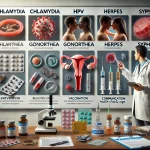Cancer is a leading cause of death worldwide, with millions of new cases diagnosed annually. Understanding the most common types of cancer, their symptoms, risk factors, and prevention strategies is crucial for reducing their global burden. Below is an in-depth analysis of the five most common cancers.
1. Lung Cancer
What is it?
Lung cancer begins in the lungs and is one of the most diagnosed cancers worldwide. It has two main types: non-small cell lung cancer (NSCLC) and small cell lung cancer (SCLC).
Symptoms
- Persistent cough or changes in a chronic cough.
- Coughing up blood.
- Shortness of breath.
- Chest pain.
- Unexplained weight loss and fatigue.
Risk Factors
- Smoking (responsible for 85% of cases).
- Exposure to secondhand smoke.
- Environmental pollutants (e.g., radon, asbestos).
- Family history of lung cancer.
Prevention
- Avoid smoking and exposure to tobacco smoke.
- Test homes for radon.
- Use protective equipment in workplaces with hazardous materials.
Diagnosis and Treatment
- Diagnosed through imaging tests (X-ray, CT scan), biopsies, or bronchoscopy.
- Treatment options include surgery, chemotherapy, radiation therapy, and targeted therapies.
Global Statistics
- Asia: Accounts for 40% of global lung cancer cases due to high smoking rates.
- North America: Lung cancer is the second most diagnosed cancer.
- Europe: High prevalence, particularly in Eastern Europe.
2. Breast Cancer
What is it?
Breast cancer occurs when cells in the breast grow uncontrollably. It is most common among women but can also affect men.
Symptoms
- Lump or thickening in the breast or underarm.
- Changes in the size, shape, or appearance of the breast.
- Nipple discharge or inversion.
- Skin changes, such as dimpling or redness.
Risk Factors
- Family history and genetic mutations (e.g., BRCA1, BRCA2).
- Hormonal factors (early menstruation or late menopause).
- Obesity and lack of physical activity.
- Alcohol consumption.
Prevention
- Regular mammograms and self-examinations.
- Maintain a healthy weight and exercise regularly.
- Limit alcohol intake.
Diagnosis and Treatment
- Diagnosed through mammograms, ultrasounds, and biopsies.
- Treated with surgery, chemotherapy, radiation, hormonal therapy, and targeted treatments.
Global Statistics
- Worldwide: The most common cancer among women, accounting for 25% of all female cancer diagnoses.
- North America and Europe: High survival rates due to early detection and advanced treatments.
- Asia and Africa: Rising incidence due to lifestyle changes and limited screening programs.
3. Colorectal Cancer
What is it?
Colorectal cancer starts in the colon or rectum and is the third most common cancer globally.
Symptoms
- Changes in bowel habits (diarrhea, constipation).
- Blood in stool or rectal bleeding.
- Abdominal pain or cramping.
- Unexplained weight loss and fatigue.
Risk Factors
- Family history of colorectal cancer or polyps.
- Diet high in red and processed meats.
- Sedentary lifestyle.
- Obesity, smoking, and alcohol consumption.
Prevention
- Eat a diet rich in fruits, vegetables, and whole grains.
- Regular exercise and maintaining a healthy weight.
- Screening tests like colonoscopy starting at age 45 or earlier for high-risk individuals.
Diagnosis and Treatment
- Diagnosed through colonoscopy, stool tests, and imaging.
- Treated with surgery, chemotherapy, radiation, and immunotherapy.
Global Statistics
- North America and Europe: High prevalence but improving survival rates due to widespread screening.
- Asia: Rapidly increasing cases due to dietary changes.
- Africa: Lower incidence but often diagnosed in advanced stages.
4. Prostate Cancer
What is it?
Prostate cancer affects the prostate gland in men and is highly common, especially in older age groups.
Symptoms
- Frequent urination, especially at night.
- Weak or interrupted urine flow.
- Blood in urine or semen.
- Pain in the lower back, hips, or pelvis.
Risk Factors
- Age (most cases occur in men over 50).
- Family history of prostate cancer.
- High-fat diet and obesity.
- Ethnicity (higher incidence in African-American men).
Prevention
- Maintain a healthy diet rich in fruits and vegetables.
- Regular physical activity and maintaining a healthy weight.
- Discuss PSA (prostate-specific antigen) screening with a doctor.
Diagnosis and Treatment
- Diagnosed through PSA tests, digital rectal exams, and biopsies.
- Treated with active surveillance, surgery, radiation, hormone therapy, or chemotherapy.
Global Statistics
- North America and Europe: High detection rates due to routine PSA screenings.
- Asia: Lower incidence but increasing due to lifestyle changes.
- Africa: Often diagnosed at later stages with poorer outcomes.
5. Skin Cancer (Melanoma and Non-Melanoma)
What is it?
Skin cancer develops in skin cells due to DNA damage, often from UV radiation. Melanoma is the most dangerous type, while basal and squamous cell carcinomas are more common but less severe.
Symptoms
- New or changing moles or skin lesions.
- Asymmetry, irregular borders, uneven colors, or large diameter in moles.
- Lesions that bleed, itch, or do not heal.
Risk Factors
- Prolonged UV exposure (sun or tanning beds).
- Fair skin, freckles, and light-colored eyes.
- Family history of skin cancer.
- A history of severe sunburns.
Prevention
- Use sunscreen with SPF 30 or higher.
- Wear protective clothing and avoid tanning beds.
- Regularly check your skin for changes.
Diagnosis and Treatment
- Diagnosed through skin examinations and biopsies.
- Treated with excision, Mohs surgery, radiation, or immunotherapy.
Global Statistics
- Australia: The highest skin cancer rates globally due to high UV exposure.
- North America and Europe: Rising cases of melanoma due to tanning trends.
- Africa and Asia: Lower incidence but poorer outcomes due to late detection.
Conclusion
Understanding the symptoms, risk factors, and prevention strategies for the most common cancers is vital for early detection and effective treatment. Adopting a healthy lifestyle, undergoing regular screenings, and raising awareness can significantly reduce cancer prevalence and mortality rates globally.
















